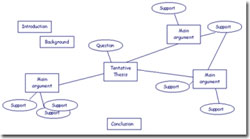Having efficient note taking skills is almost a requirement to be successful in college. No matter what class you are taking or what project you are working on, you will most likely need to take notes or outline your ideas and other information you take in during lectures. With that in mind, it is no surprise that new techniques for taking notes come into play everyday. One technique that is becoming increasingly popular and helping college students attain success is mind mapping.
What is Mind Mapping?
Although mind mapping has been around for hundreds of years, it has been heavily researched and perfected in the past ten years. A mind map is where you take your main topic or idea and arrange words, tasks, and more ideas and diagram them around your main idea. Think of your main topic as a tree: you will have words and other ideas coming off the tree (or your main topic) that simulate branches. Just as branches are important to a tree, the keywords and other information are important to your main topic. This type of note taking promotes creativity and assists you with problem solving. It helps your brain remember the information better than traditional note taking.
Why Should You Use Mind Mapping?
Mind mapping has proven to help students become more successful in remembering the information they hear during lectures. Rather than the list format of note taking, you are jotting down quick keywords and important information all on one page in your notebook. It is easier to study as you only have one page of keywords and important ideas, rather than pages and pages of notes and definitions. Studies also show that your brain is more likely to retain the information that you “map” as mind mapping is more of a two dimensional structure, enabling your brain to memorize facts that you see on paper much easier.
How Do You Mind Map?
Surprisingly, mind mapping is relatively easy and once you try it you'll be hooked. Here is a quick tutorial on how to mind map:
- Write down the main topic or idea in the middle of your page and circle it.
- Take your subheadings/subcategories and add them to your map by drawing a line out from your circle.
- If you come across additional information that would fit within the subheadings, then you will want to draw a line from those subheadings and add your information there.

Think of a mind map as a 2D Outline. Instead of the list with Roman Numerals and letters for subheadings, you have a tree with branches that visually portray your information. It is easy to add new information, as all you have to do is add a line to your map.
Mind mapping is easy to do and becomes an extremely useful tool when studying. You can look at your map and visualize the information in relation to your map, which will make it easier when you are trying to recall facts or important ideas during an exam.
